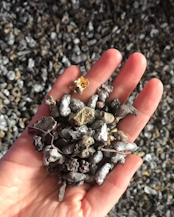Replacement of raw materials in the circular economy

Replacement of raw materials in the circular economy
- Our Objective
The use of secondary raw materials conserves primary resources and can make a significant contribution to reducing CO2 emissions, for example of construction materials. Through detailed material investigations and in close cooperation with potential recyclers in industry, this project investigates the recycling potential of mineral wastes that are currently landfilled. The use of promising secondary raw materials will be tested in industrial experiments with the aim of establishing more sustainable building materials through an increased recycling rate of secondary raw materials. This will protect the environment and close material cycles in a sustainable way.
- Figures
The project was launched on January 1, 2022 and is currently in progress.
Summary
A large part of the waste volume in Switzerland—and in the Canton of Bern—is mineral waste in the form of excavated and demolition materials, as well as residues from municipal/industrial waste- and wood incineration. These materials are nowadays deposited in landfills in large quantities, as they often do not yet meet the quality criteria for recycling and require further processing. This places a heavy burden on Switzerland's limited landfill volume, and valuable raw materials are also lost to the mineral resource cycle. The procurement of new building materials, so-called primary raw materials, is very energy- and CO2-intensive, while their recycling reduces the amount of waste as well as the environmental impact. The resulting secondary raw materials can be reused in the domestic construction industry.
The AWA-1 project is being carried out in collaboration with the Office for Water and Waste Management of the Canton of Bern, with support from IT company Fink & Partner: LIMS-Software.
Project Connections
Timeline
Turning waste into resources for a circular economy
Project Update February 2, 2023
Many demolition materials, which are classified as low-grade today, nevertheless have a great potential for recycling. Thus, in order to conserve primary raw material reserves and close material cycles in a sustainable way, the end-of-pipe mentality must be broken. The project Substitute Raw Materials in the Circular Economy makes a valuable contribution to closing raw material cycles by creating the necessary basis for the recycling of secondary raw materials. The project aims to investigate the material streams currently deposited in landfills for their potential for recovery, recycling and up-cycling in the construction industry in order to close material cycles in a sustainable manner. For a secondary raw material to replace a primary resource, it must meet specific requirements. The necessary requirements for further processing into a secondary raw material are identified together with the recycling industry (e.g. cement plants). The recycling potential of the following material streams will be investigated in a first phase of the project: Concrete demolition waste: Although concrete demolition waste is already recycled to a large extent in Switzerland, the recycling of selectively processed concrete demolition waste in clinker production is being tested as part of this project in a cradle-to-cradle approach, which should lead to a greatly improved CO2 balance in clinker production on the one hand, and also to a better quality of recycled concrete. Excavated and quarried material: In terms of quantity, the recycling of bulk mineral raw materials is the most effective means of implementing the desired circular economy. In this project, the recycling potential of excavated and quarried material from infrastructure projects is investigated. Different fractions from processing plants: Material flows can only rarely be recycled directly; in most cases, upstream processing techniques are required to prevent them from being deposited in landfills. With modern processing plants, different materials (excavated material, demolition material, drilling mud, etc.) can be processed using various chemical and physical methods. Within the scope of this project, various material streams from different processes will be examined for their material qualities and recycling possibilities. Bottom ash from municipal solid waste incineration (MSWI): Today, only the metals are recovered from MSW incineration residues; the entire mineral fraction of these residues is deposited in landfills and is thus lost to the mineral raw material cycle. Within the scope of this project, the possibilities of using the residues in cement plants and as aggregates are to be investigated. Wood ash: While filter ashes from waste wood incineration are subject to a heavy metal recovery obligation from 11.2025, grate and bed ashes are deposited in landfills largely unused. Due to their geochemical properties, grate and bed ashes in particular are considered to be a promising secondary raw material in clinker production, whereby an improved CO2 balance can also be achieved through partial replacement. In a second phase of the project, implementation experiments will be performed (e.g. on a laboratory and pilot scale) with promising material streams. The project is intended to build the knowledge basis for establishing the maximum use of secondary raw materials in the long term, for example in clinker production. The gained knowledge will be applicable nationally as well as internationally.
Team
- Project contactProject contact
Cyrill Hess
Research Scientist

